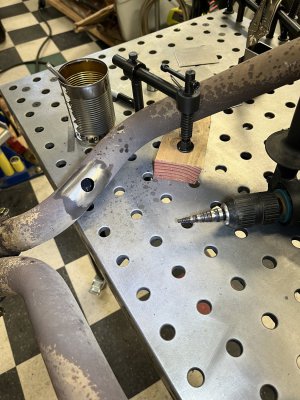What's your goal with this?
No short answer for “what’s my goal”, so indulge me in a bit of bare-bones D-Jet history.
Bosch D-Jetronic is a speed-density system with no means of closed-loop operation. None. It has no O2-sensor and no means to measure the AFR. It was introduced in the late 60s and was used by Mercedes, Porsche (in the 914), VW, Volvo, Jaguar and Saab up to the mid-70s. The Electronic Control Unit, ECU, is an impressive exercise in analog electronics. No integrated circuits, nothing digital. It is a “fuel only” system where ignition and timing are handled by a mechanical distributor and points.
The fuel mixture is set by the injector pulse length and the fuel pressure. A manifold pressure sensor, MPS, senses the manifold vacuum using a metal diaphragm attached to a variable coil (an inductor, L). The ECU uses this L value in an electronic decay circuit to establish a variable vacuum-dependent injector pulse length. (I am skipping several details that aren’t relevant to this discussion. If you want more info, ask and I’ll put up several links.)
Now, Bosch built the MPS to specific parameters and did a final adjustment at the factory using a rather poorly hidden screw which fiddles the pre-load on the diaphragm. The calibration used for this remains a tightly-held secret at Bosch. Of course, mechanics in the field quickly began fiddling the MPS screw and the fuel pressure to make cars run “better” for their customers. This was all done ad-hoc using seat-of-the-pants reconning.
In the present day, MPS’s are aging and most of them have been adjusted for better or worse. Bosch will refurb and calibrate the MPS at significant expense. We think they use the same old calibration stand from the 70s. A couple of clever Mercedes enthusiasts have obtained two “known good” MPS’s and figured out how to adjust the screw on unknown MPS’s to get a reasonable match with the known good ones. This puts the MPS coil setting back to a good value at a particular vacuum level.
I am hoping bolster this with AFR measurements on the road. Thus, with my car ( a 1972 Mercedes 350SL) I am installing an O2 sensor and a vacuum sensor to data log AFR, vacuum, and RPM at various engine loads. After I have this baseline data we’ll remove the MPS to measure and reset the coil. After that, get new data and see what happened.
Beyond that is uncertain. If the mixture is still very rich at all loads and conditions I may tweak the screw in an iterative fashion seeking improvement.
And, for you viewers at home. The only reason I am using an old LM-1 meter is that I bought it in 2006-2007 when I put a blower and bigger injectors on my Tacoma and re-mapped it. Otherwise, I’d definitely use a new meter. I am even using the old laptop running Windows Vista!







